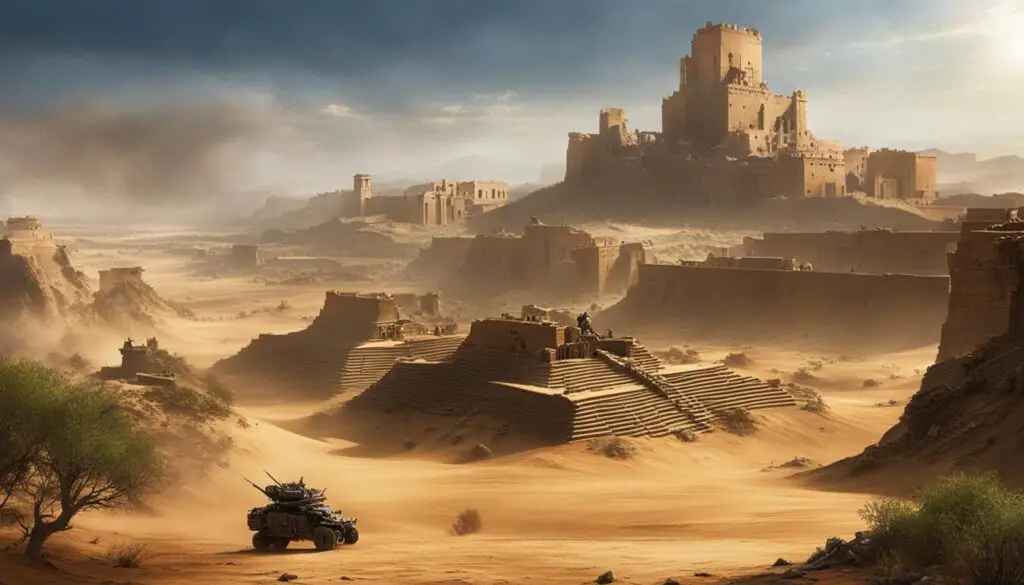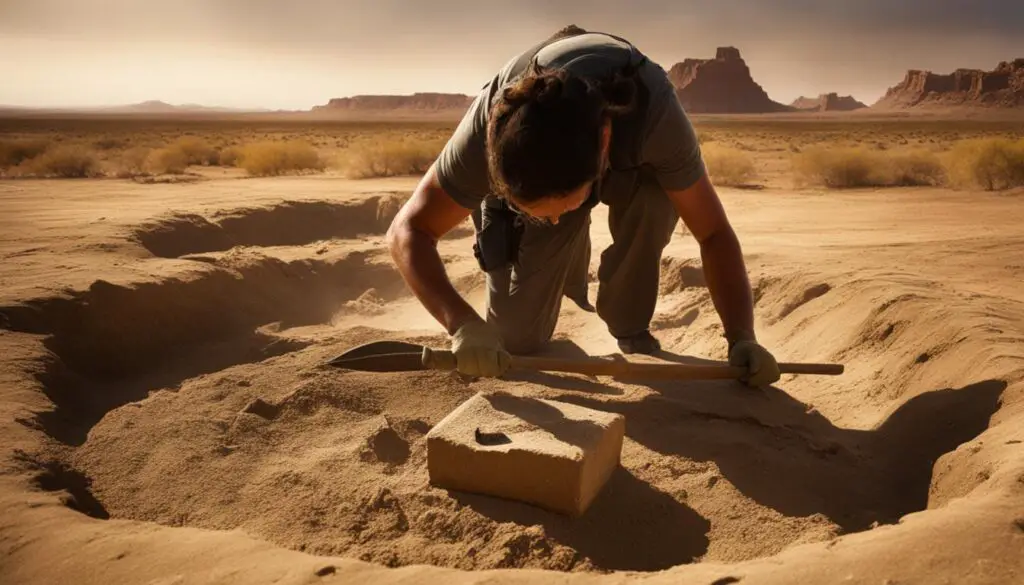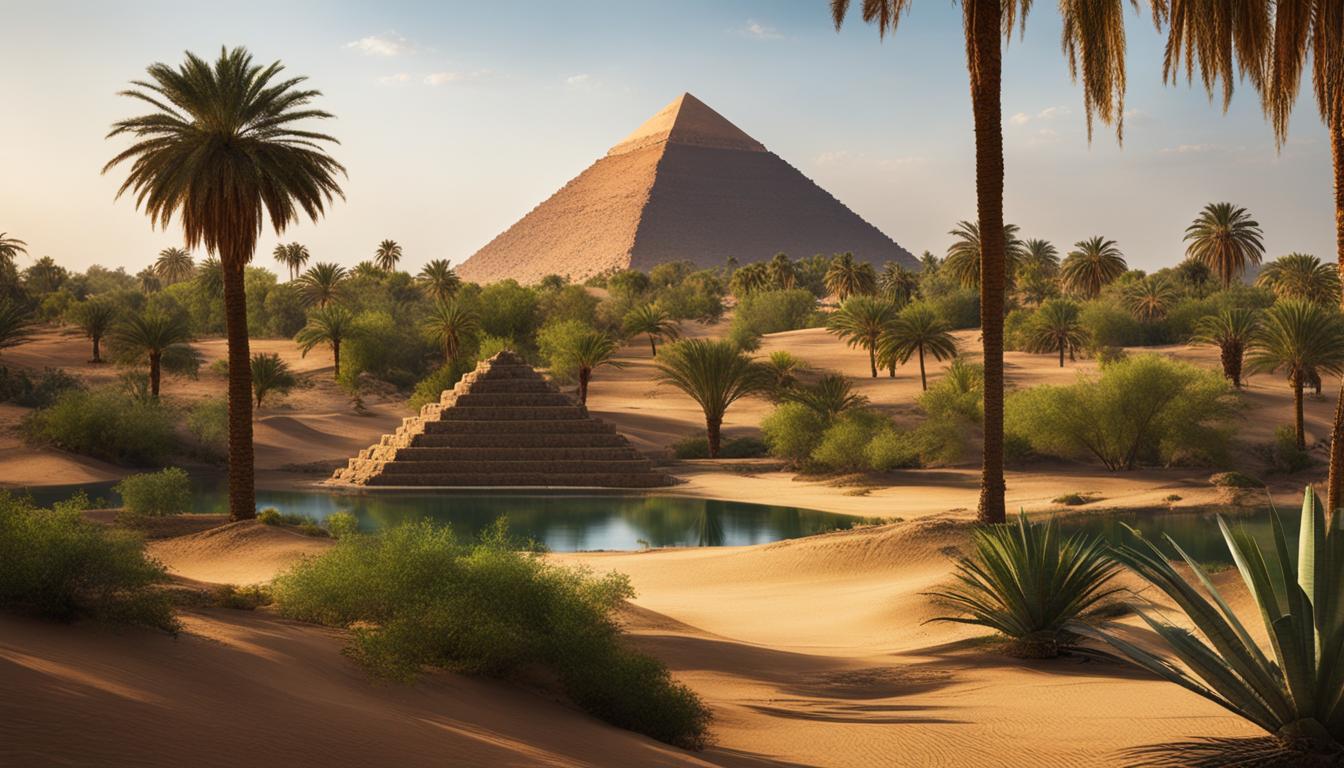Biblical places hold immense historical and religious significance. These sacred sites offer a glimpse into the rich history of the Bible. From the Land of Israel and Judea to ancient Near Eastern lands, key locations in the life of Jesus, and prophetic places, there are numerous destinations that are of great importance to believers around the world.
Key Takeaways:
- Exploring biblical places provides a deeper understanding of the Bible and its teachings.
- The Land of Israel and Judea are at the heart of biblical history.
- Ancient Near Eastern lands hold cultural and historical significance.
- Key locations in the life of Jesus offer insights into his teachings and miracles.
- Prophetic places hold symbolic meanings and reveal messages conveyed by the prophets.
The Land of Israel and Judea
The Land of Israel and Judea are central to biblical history and hold significant religious and historical importance. Jerusalem, the capital of Israel, is a city revered by Jews, Christians, and Muslims alike. It is home to numerous sacred sites, including the Western Wall, the Church of the Holy Sepulchre, and the Dome of the Rock. Bethlehem, located in the West Bank, is renowned as the birthplace of Jesus and attracts pilgrims from around the world.
The region of Judea is associated with many biblical stories and figures. It was in this land that David became king and Jesus began his ministry. The Judean Desert, with its rugged landscapes and ancient monasteries, offers a spiritual and reflective experience for visitors. Exploring the land of Israel and Judea provides a deeper understanding of the Bible and allows one to walk in the footsteps of biblical characters. ancient biblical cities
Key Sites in the Land of Israel and Judea
Below is a table highlighting some key sites in the Land of Israel and Judea:
| Site | Location | Significance |
|---|---|---|
| Jerusalem | Israel | Cultural, religious, and historical significance for multiple faiths |
| Bethlehem | West Bank | Birthplace of Jesus; pilgrimage site for Christians |
| Western Wall | Jerusalem | Remnant of the Second Temple; important location for Jewish prayer |
| Church of the Holy Sepulchre | Jerusalem | Believed to be the site of Jesus’ crucifixion, burial, and resurrection; significant to Christians |
Visiting these sites allows individuals to connect with their faith, experience the rich history of the Bible, and gain a deeper appreciation for the cultural and religious significance of the Land of Israel and Judea.
Ancient Near Eastern Lands

The ancient Near East is a region of great historical and cultural significance, closely connected to the stories and events of the Bible. It encompasses Mesopotamia, Egypt, and Babylon, among other prominent civilizations. Exploring these lands provides valuable insights into the context and background of many biblical stories, allowing us to better understand the ancient world that shaped the narratives we read today. holy sites of the bible
Mesopotamia, often referred to as the “cradle of civilization,” was home to the Sumerians, Babylonians, and Assyrians. This region witnessed the rise and fall of powerful empires, such as the famous Code of Hammurabi and the creation of the Hanging Gardens of Babylon. Numerous biblical figures, such as Abraham and Daniel, had connections to Mesopotamia, making it an essential destination for those seeking to delve into biblical history.
Egypt holds a special place in the Bible due to its significant role in the story of Moses and the exodus of the Israelites. The ancient Egyptian civilization left behind remarkable architectural wonders, including the pyramids, the Sphinx, and the temples of Luxor and Karnak. Exploring these sites provides a deeper understanding of the biblical narrative and the intersection between Israelite culture and ancient Egyptian society. sacred places in the bible
| Ancient Near Eastern Lands | Description |
|---|---|
| Mesopotamia | An ancient region known for its powerful empires and contributions to civilization. |
| Egypt | Ancient land associated with the story of Moses and the exodus of the Israelites. |
| Babylon | Ancient city famed for its hanging gardens and the Code of Hammurabi. |
Babylon played a prominent role in biblical history, particularly during the exile of the Israelites. The city’s grandeur and the famous Hanging Gardens were among the wonders of the ancient world. Journeying to Babylon offers an opportunity to witness the remnants of this once-great civilization and gain a deeper appreciation for the biblical accounts that unfolded within its walls. biblical pilgrimage sites
By exploring the ancient Near Eastern lands of Mesopotamia, Egypt, and Babylon, we can gain a greater appreciation for the historical and cultural context of the Bible. These regions offer a wealth of archaeological sites and historical landmarks that bring the biblical narratives to life, allowing us to connect more deeply with the stories and teachings that have shaped the world for centuries. biblical archaeological sites
Key Locations in the Life of Jesus
Nazareth, Galilee, and the Sea of Galilee are key locations in the life of Jesus. These places hold immense significance in Christian tradition and are popular destinations for pilgrims and tourists. Let’s explore these biblical sites and the events associated with them. prophetic locations
Nazareth
Nazareth is the hometown of Jesus and the place where he grew up. It is located in the Galilee region of Israel. The city is mentioned in the New Testament as the place where Jesus spent his childhood and early adulthood. Today, visitors can explore the Basilica of the Annunciation, a major pilgrimage site that commemorates the angel Gabriel’s announcement to Mary about the birth of Jesus.
Galilee
The region of Galilee played a significant role in the ministry of Jesus. It is where he performed many miracles and delivered profound teachings. The serene landscapes and picturesque towns of Galilee offer visitors a chance to experience the tranquility and spirituality that inspired Jesus’ ministry. Pilgrims can visit sites like Capernaum, Tabgha, and the Mount of Beatitudes, where Jesus performed miracles and delivered the Sermon on the Mount.
Sea of Galilee
The Sea of Galilee, also known as Lake Tiberias or Lake Kinneret, is a freshwater lake in the Galilee region. Jesus is said to have performed several miracles on its shores, including calming a storm and walking on water. The Sea of Galilee provides a beautiful backdrop for reflection and spiritual contemplation. Visitors can take boat rides on the lake and visit sites like the Church of the Primacy of St. Peter and the Mount of Beatitudes, where Jesus delivered the Sermon on the Mount.
| Location | Significance |
|---|---|
| Nazareth | Childhood home of Jesus; site of the Basilica of the Annunciation |
| Galilee | Region of Jesus’ ministry; site of miracles and teachings |
| Sea of Galilee | Location of Jesus’ miracles and teachings; provides a serene backdrop for reflection |
Exploring the key locations in the life of Jesus allows for a deeper understanding of his teachings and the historical context in which they took place. These sites offer a unique opportunity to connect with biblical history and spirituality, making them a must-visit for those seeking a meaningful pilgrimage experience.
Prophetic Places
Prophetic places mentioned in the Bible hold a special significance in religious and biblical history. These locations are associated with prophecies and offer deeper insights into the visions and messages conveyed by the prophets. One notable prophetic location is the Valley of Dry Bones.
The Valley of Dry Bones, also known as the Valley of Vision, is mentioned in the book of Ezekiel in the Old Testament. In this prophetic vision, the prophet Ezekiel sees a valley filled with dry bones and is commanded to prophesy to them, bringing them back to life. This powerful vision symbolizes the restoration and revival of the people of Israel and represents the hope of the resurrection and renewal.
“Prophesy over these bones and say to them, ‘Dry bones, hear the word of the Lord! This is what the Sovereign Lord says to these bones: I will make breath enter you, and you will come to life.’” – Ezekiel 37:4-5
The Valley of Dry Bones serves as a reminder of the promises of God and the importance of faith and hope in the face of adversity. It is a place of reflection and inspiration for believers, reminding them of the power of God’s restoration in their lives and the fulfillment of His prophecies.
| Key Prophetic Location | Description |
|---|---|
| The Valley of Dry Bones | A symbol of restoration and renewal in biblical prophecy, where the prophet Ezekiel saw a vision of dry bones coming back to life. |
| The Mount of Olives | Associated with various prophecies in the Bible, including the future return of Jesus Christ and the final battle between good and evil. |
| Mount Carmel | The site of the prophet Elijah’s showdown with the prophets of Baal, showcasing the power of God and His faithfulness to His people. |
Places of Worship and Religious Significance

Places of worship have played a crucial role in biblical history. The Tabernacle, Solomon’s Temple, and the Second Temple are examples of structures associated with worship and religious ceremonies in ancient times. These sites are of great cultural and historical importance.
The Tabernacle
The Tabernacle, also known as the Tent of Meeting, was a portable sanctuary used by the Israelites during their journey in the wilderness. It was a place of worship where sacrifices were offered and where Moses would meet with God. The Tabernacle was intricately designed with specific instructions given by God, and its construction and rituals were central to the religious life of the ancient Israelites.
Solomon’s Temple
Solomon’s Temple, built in Jerusalem by King Solomon, was a grand and magnificent structure that served as the central place of worship for the Israelites. It housed the Ark of the Covenant and was known for its elaborate decorations and magnificent craftsmanship. Solomon’s Temple was a symbol of God’s presence among His people and was a significant religious and cultural landmark in biblical times.
The Second Temple
The Second Temple, also known as Herod’s Temple, was built in Jerusalem after the return of the Israelites from exile in Babylon. It replaced the original temple that was destroyed by the Babylonians. The Second Temple was an important religious site where sacrifices were offered and religious ceremonies were conducted. It was expanded and renovated by Herod the Great, making it an even more impressive structure. The Second Temple held immense religious and historical significance for the Jewish people.
| Place of Worship | Significance |
|---|---|
| The Tabernacle | A portable sanctuary used by the Israelites during their journey in the wilderness. It was the place where Moses would meet with God and where sacrifices were offered. |
| Solomon’s Temple | A grand and magnificent structure built by King Solomon in Jerusalem. It was the central place of worship for the Israelites and housed the Ark of the Covenant. |
| The Second Temple | A temple built in Jerusalem after the return from exile in Babylon. It replaced the original temple and was a significant religious site for the Jewish people. |
These places of worship played a vital role in the religious practices of the ancient Israelites and hold immense historical and cultural value. They serve as reminders of the deep connection between faith, worship, and the biblical narrative.
Biblical Battlefields and Sites of Conflict

The Bible is replete with stories of battles and conflicts that took place in various regions. These biblical battlefields and sites of conflict offer a glimpse into the military strategies, struggles, and triumphs of ancient civilizations. Exploring these locations allows us to witness the historical events that shaped the biblical narrative.
The Battle of Jericho
One of the most famous biblical battles is the Battle of Jericho, where the Israelites, led by Joshua, conquered the fortified city of Jericho. According to the book of Joshua, the walls of Jericho collapsed after the Israelites marched around the city for seven days, blowing trumpets and shouting. This miraculous event demonstrated God’s power and served as a turning point in the Israelites’ conquest of Canaan.
The Battle of Armageddon
The Battle of Armageddon is a prophesied battle described in the book of Revelation. It signifies the final conflict between good and evil at the end of the world. While the exact location of Armageddon is disputed, it is believed to be a symbolic representation of the ultimate battle between righteousness and wickedness. The significance of Armageddon lies in its portrayal of the ultimate triumph of God’s kingdom.
| Biblical Battlefields and Sites of Conflict | Location | Significance |
|---|---|---|
| The Battle of Jericho | Jericho, West Bank | Showcased God’s power and marked the beginning of the Israelites’ conquest of Canaan |
| The Battle of Armageddon | Location disputed, believed to represent a future battle | Symbolizes the final conflict between good and evil at the end of the world |
These biblical battlefields and sites of conflict not only provide historical insights but also offer opportunities for reflection on the moral and spiritual lessons conveyed in the Bible. They serve as reminders of the perseverance, faith, and divine intervention that played a role in the lives of the ancient Israelites and other biblical figures. Visiting these sites allows us to connect with the stories of the past and gain a deeper understanding of the cultural and religious significance they hold.
The Land of Israel and Judea

The land of Israel and Judea is steeped in biblical history, with numerous sacred sites that attract visitors from around the world. Jerusalem, the capital of Israel, holds great significance for Jews, Christians, and Muslims alike. It is home to iconic landmarks such as the Western Wall, the Church of the Holy Sepulchre, and the Dome of the Rock.
Another important biblical location in this region is Bethlehem, known as the birthplace of Jesus. Pilgrims flock to the Church of the Nativity to pay homage to the site of Jesus’ birth. The picturesque landscapes of Galilee and the serene waters of the Sea of Galilee provide a peaceful retreat where Jesus performed many miracles and delivered teachings, including the renowned Sermon on the Mount.
| Landmarks | Description |
|---|---|
| Jerusalem | Ancient city with significant religious sites for Judaism, Christianity, and Islam. |
| Bethlehem | The birthplace of Jesus, featuring the Church of the Nativity. |
| Galilee | A picturesque region where Jesus performed miracles and delivered teachings. |
| Sea of Galilee | A serene body of water associated with Jesus’ ministry and miracles. |
Visiting these biblical sites in the land of Israel and Judea offers a unique opportunity to connect with the stories and teachings of the Bible, immersing oneself in the rich cultural and religious heritage of the region.
Mount Sinai and the River Jordan
In addition to the prominent landmarks mentioned above, biblical history is also intertwined with various geographical features in the region. Mount Sinai, located in the southern part of the Sinai Peninsula, is believed to be the mountain where Moses received the Ten Commandments from God. The awe-inspiring mountain serves as a reminder of the profound spiritual experiences described in biblical accounts.
The River Jordan, flowing through Israel, the West Bank, and Jordan, holds great biblical significance. It was the site of many important events, including the baptism of Jesus by John the Baptist. Pilgrims often visit the Jordan River to reaffirm their faith and participate in baptismal ceremonies.
“Mount Sinai and the River Jordan are powerful symbols of spiritual revelation and purification, providing a profound connection to the biblical narrative.” – Anonymous
Exploring the regions and geographical features mentioned in the Bible, such as deserts, rivers, mountains, Mount Sinai, and the River Jordan, allows visitors to gain a deeper understanding of the landscapes and environments in which biblical events unfolded. It is an opportunity to walk in the footsteps of the biblical figures and embrace the historical and spiritual significance of these landmarks.
Archaeological Discoveries

The exploration of biblical places has been greatly enhanced by archaeological discoveries. These findings provide tangible evidence of the existence of ancient cities, landmarks, and events mentioned in the Bible, offering invaluable insights into biblical times and cultures. Through the field of biblical archaeology, researchers have unearthed artifacts and structures that validate and illuminate the stories and teachings of the Bible.
One notable archaeological discovery is the Tel Dan Stele, a stone slab containing an inscription that mentions the “House of David.” This inscription is the first extra-biblical evidence of King David’s existence, providing historical context to the stories of his reign. Another significant find is the Dead Sea Scrolls, a collection of ancient Jewish texts discovered in the mid-20th century. These scrolls include fragments of biblical books and other religious writings, shedding light on the religious practices and beliefs of the time.
Excavations in biblical sites such as Jericho, Megiddo, and Hebron have revealed architectural remains, pottery, and other artifacts that offer insights into the daily lives and customs of ancient civilizations. These discoveries help to corroborate biblical accounts and enhance our understanding of the historical and cultural context in which the biblical events took place.
| Archaeological Discoveries | Description |
|---|---|
| Tel Dan Stele | A stone slab with an inscription mentioning the “House of David,” providing evidence of King David’s existence. |
| Dead Sea Scrolls | A collection of ancient Jewish texts that include fragments of biblical books and other religious writings. |
| Excavations in biblical sites | Unearthing architectural remains, pottery, and artifacts that offer insights into the daily lives of ancient civilizations. |
These archaeological discoveries not only contribute to our understanding of biblical history but also enrich the visitor experience at biblical sites. By witnessing the physical remnants of the past, visitors can connect more deeply with the stories and events described in the Bible.
Implications and Future Research
The ongoing field of biblical archaeology continues to uncover new insights into ancient biblical civilizations. With advances in technology and research methods, archaeologists are able to extract more detailed information from excavations, further expanding our understanding of biblical history. Future research may focus on lesser-known biblical sites, as well as the exploration of underwater archaeological sites linked to biblical narratives.
“Archaeology allows us to dig into the layers of the past, uncovering the physical remains that validate the stories and teachings of the Bible. These discoveries bridge the gap between ancient history and modern faith, providing a tangible connection to the biblical world.”
As archaeological techniques and methodologies evolve, it is likely that more significant discoveries will emerge, shedding light on previously unknown aspects of biblical history. Continued collaboration between archaeologists, historians, and biblical scholars will contribute to a deeper understanding of the ancient biblical world and its enduring significance.
Cultural Significance and Modern Relevance

Biblical places hold not only religious but also significant cultural importance. These sacred sites have had a profound influence on art, literature, and music throughout history. Artists have found inspiration in the stories and teachings emanating from these locations, creating masterpieces that continue to captivate audiences to this day. From Renaissance paintings depicting biblical events to contemporary songs inspired by faith, the cultural impact of these places is undeniable.
Moreover, these biblical sites remain relevant in modern times for various reasons. They continue to attract pilgrims from all over the world who seek spiritual fulfillment and a deeper connection to their faith. Visitors come to these places to reflect, meditate, and experience a sense of peace and tranquility. The power of these sanctified locations to calm the mind and nourish the soul is unmatched.
“Visiting these biblical places allows us to see beyond the present moment and connect with something that has shaped human history for centuries. It’s a powerful reminder of our shared heritage.”
Additionally, these sites serve as educational resources, offering valuable insights into ancient civilizations and their way of life. Scholars, archaeologists, and history enthusiasts study these locations and the artifacts discovered within them, expanding our knowledge of the past and shedding light on the historical accuracy of biblical accounts.
| Biblical Places | Cultural Significance | Modern Relevance |
|---|---|---|
| Jerusalem | Center of three major world religions | Pilgrimages, interfaith dialogue |
| Nazareth | Birthplace of Jesus | Pilgrimages, Christian heritage |
| Bethlehem | Birthplace of Jesus | Pilgrimages, Christmas traditions |
| Mount Sinai | Where Moses received the Ten Commandments | Spiritual retreats, hiking |
| Sea of Galilee | Setting for Jesus’ miracles and teachings | Boat tours, reflection |
The cultural significance and modern relevance of biblical places continue to inspire and provide meaningful experiences for people from all walks of life. Whether it is through art, pilgrimage, education, or spiritual reflection, these extraordinary sites have left an indelible mark on our world and continue to fascinate and inspire generations.
Political Issues and Travel to Biblical Places
Traveling to biblical places can sometimes be affected by political issues and conflicts in the regions where these sites are located. It’s important to consider the current geopolitical situation before planning a visit. While these challenges may exist, many people still embark on pilgrimages to these holy sites, seeking spiritual fulfillment and a deeper connection to their faith.
The land of Israel and Judea, ancient Near Eastern lands, key locations in the life of Jesus, prophetic places, places of worship and religious significance, biblical battlefields and sites of conflict, and regions and geographical features all offer unique opportunities for exploration. However, it’s crucial to stay informed about any travel advisories or restrictions in place and to respect the local customs and sensitivities when visiting these sacred sites.
Pilgrimage is a key aspect of many religious traditions, and for believers, visiting these biblical places can be a deeply meaningful and transformative experience. It allows them to walk in the footsteps of prophets, kings, and other biblical figures, and to connect with the stories and teachings that have shaped their faith.
Pilgrimage to Biblical Sites
For many, traveling to biblical places is not just a tourist excursion, but a sacred journey. It’s an opportunity to experience a sense of awe and reverence, to meditate and pray in places with immense historical and spiritual significance. Whether it’s walking through the streets of Jerusalem, standing on the shores of the Sea of Galilee, or visiting the birthplace of Jesus in Bethlehem, these experiences can deepen one’s connection to their faith and provide a profound sense of spiritual fulfillment.
However, it’s essential to approach travel to biblical places with sensitivity and respect. It’s important to be aware of the political issues surrounding these sites and to understand that they may be situated in regions with ongoing conflicts or sensitive geopolitical situations. This awareness allows travelers to navigate these challenges responsibly while still having the opportunity to connect with the rich history and spirituality of these destinations.
Pilgrimage to biblical places is a deeply personal and individual journey. While there may be political issues and travel restrictions to consider, the desire to connect with one’s faith often transcends these challenges. By approaching travel to biblical places with an open heart and a spirit of respect, visitors can embark on a meaningful pilgrimage that nourishes their spiritual lives and deepens their understanding of the sacred stories and places of the Bible.
| Biblical Places | Political Issues | Travel Considerations |
|---|---|---|
| Land of Israel and Judea | Border disputes, conflicts | Stay informed of current geopolitical situation, check for travel advisories |
| Ancient Near Eastern Lands | Political instability | Respect local customs and sensitivities, be aware of travel restrictions |
| Key Locations in the Life of Jesus | Security concerns | Follow guidance from local authorities, travel with reputable tour operators |
| Prophetic Places | Sensitive geopolitical situations | Observe local regulations, maintain respectful behavior |
| Places of Worship and Religious Significance | Cultural and religious tensions | Be mindful of dress codes, respect religious practices |
| Biblical Battlefields and Sites of Conflict | Ongoing conflicts | Stay away from active conflict areas, follow advice from local authorities |
| Regions and Geographical Features | Political disputes | Plan travel routes accordingly, avoid areas of heightened tension |
Historical Significance and Religious Sites
The biblical places mentioned in the previous sections hold immense historical significance, providing a tangible connection to the events and figures of the Bible. These sites offer a deeper understanding of the stories and teachings that have shaped the world’s religious beliefs and practices. Furthermore, they serve as important destinations for worship and reflection, attracting millions of pilgrims and visitors each year.
The Land of Israel and Judea
The land of Israel and the region of Judea are at the heart of biblical history. With cities like Jerusalem and Bethlehem, these areas are key destinations for believers seeking to explore the birthplace of Jesus and other significant biblical landmarks. These sacred sites provide a glimpse into the life and teachings of Jesus, allowing visitors to walk in the footsteps of biblical figures and experience the deep spiritual connection associated with these locations.
Ancient Near Eastern Lands
The ancient Near East, including regions like Mesopotamia, Egypt, and Babylon, holds great cultural and historical significance in the biblical narrative. Exploring these lands provides valuable insights into the context and background of many biblical stories. The architectural wonders, artifacts, and remnants of ancient civilizations found in these regions give visitors a deeper appreciation for the rich history and cultural heritage associated with the Bible.
Places of Worship and Religious Significance
Places of worship play a vital role in biblical history and continue to hold religious and cultural importance. Structures like the Tabernacle, Solomon’s Temple, and the Second Temple are not only architectural marvels but also symbols of faith and devotion. Churches, mosques, and monasteries built atop or near these historical sites stand as testaments to the enduring presence of religious practices and communities throughout the centuries.
Visionary Places and Sites of Conflict
Visionary places mentioned in the Bible bring to life the spiritual experiences and divine revelations of biblical figures. These sites offer glimpses into the supernatural and the divine. From the burning bush on Mount Horeb where God spoke to Moses, to the Mount of Transfiguration where Jesus revealed His glory to His disciples, these visionary places hold profound significance for believers. They serve as reminders of the awe-inspiring power of God and His interaction with humanity.
On the other hand, sites of conflict mentioned in the Bible provide historical insights into the challenges and struggles faced by the ancient Israelites and other biblical civilizations. The city of Jericho, with its formidable walls, witnessed a miraculous victory for the Israelites as they marched around its walls, causing them to crumble. This event, recorded in the book of Joshua, symbolizes the power of faith and divine intervention in the face of seemingly insurmountable obstacles.
“By faith the walls of Jericho fell, after the army had marched around them for seven days” – Hebrews 11:30 (NIV)
Geographical features also play a significant role in the biblical narrative. The River Jordan, where Jesus was baptized by John the Baptist, serves as a symbol of spiritual cleansing and rebirth. This iconic river flows through the region of Jordan and holds deep historical and religious significance for believers. Mount Sinai, where Moses received the Ten Commandments from God, is another geographical feature that resonates with biblical accounts and provides a tangible connection to the events of the Exodus.
| Visionary Places | Sites of Conflict | Geographical Features |
|---|---|---|
| Mount Horeb | Jericho | River Jordan |
| Mount of Transfiguration | Mount Sinai | |
Exploring these visionary places, sites of conflict, and geographical features offers not only historical insights but also a deeper understanding of the faith and spirituality encapsulated in the Bible. These locations allow believers to connect with the stories and experiences of biblical figures, inspiring awe and reverence for the divine.
Historical Insights and Spiritual Reflection
- Visiting visionary places provides a glimpse into the supernatural and divine experiences of biblical figures.
- Sites of conflict offer historical insights into the challenges faced by ancient civilizations in biblical times.
- Geographical features such as rivers and mountains hold symbolic and religious significance.
- Exploring these locations allows for spiritual reflection and a deeper understanding of biblical teachings.
By immersing oneself in these biblical landscapes, believers can gain a greater appreciation for the history, spirituality, and enduring relevance of the Bible.
Conclusion
Exploring biblical places is a captivating journey through history and spirituality. These sacred destinations offer a deeper understanding of the Bible and its teachings, allowing for a profound connection to one’s faith. Whether embarking on a pilgrimage or seeking historical insights, visiting these biblical destinations provides a unique opportunity to experience the sacred places mentioned in the Bible.
The Land of Israel and Judea, with cities like Jerusalem and Bethlehem, hold immense historical significance. Ancient Near Eastern lands, such as Mesopotamia and Egypt, offer insights into the context of biblical stories. Key locations in the life of Jesus, such as Nazareth and Galilee, bring to life the events and teachings of the Messiah.
Prophetic places, like the Valley of Dry Bones, hold symbolic meanings and offer glimpses into the visions of the prophets. Places of worship, such as the Tabernacle and Solomon’s Temple, remind us of the religious rituals and ceremonies in ancient times. Biblical battlefields, like Jericho and Armageddon, provide historical insights into the conflicts described in the Bible.
The regions and geographical features mentioned in the Bible, including deserts, rivers, mountains, and specific landmarks, help us visualize the landscapes and environments of biblical times. Through archaeological discoveries, we gain tangible evidence of the existence of biblical cities and events. These historic biblical locations continue to inspire and educate people from all walks of life, inviting them to dive deeper into the rich tapestry of biblical history.
FAQ
What are some examples of biblical places?
Examples of biblical places include Jerusalem, Bethlehem, Nazareth, Galilee, and the Sea of Galilee.
Why are biblical places significant?
Biblical places hold immense historical and religious significance, offering insights into the rich history of the Bible and key locations in the life of Jesus.
What can I expect to see at biblical sites?
At biblical sites, you can expect to see significant landmarks, ancient ruins, places of worship, and geographical features mentioned in the Bible.
Are there any political issues that may affect travel to biblical places?
Yes, travel to biblical places can be affected by various political issues such as border disputes and conflicts in the regions where these sites are located. It’s important to consider the current geopolitical situation before planning a visit.
How can I plan a pilgrimage to biblical places?
To plan a pilgrimage to biblical places, consider researching tour operators that specialize in religious travel, checking visa requirements, and consulting with local authorities for up-to-date safety information.
Are there archaeological discoveries that support the historical accuracy of the Bible?
Yes, archaeological discoveries have shed light on biblical history and validated many stories mentioned in the Bible. These discoveries provide tangible evidence of the existence of biblical cities, landmarks, and events.
What is the modern relevance of biblical places?
Biblical places continue to hold cultural and historical importance, influencing art, literature, and music. They are also important destinations for pilgrimage, education, and spiritual reflection.
Can I visit biblical places without a religious affiliation?
Yes, biblical places are open to visitors of all faiths or those with no religious affiliation. They offer a captivating journey through history, spirituality, and an opportunity to explore ancient civilizations.
What is the significance of prophetic places mentioned in the Bible?
Prophetic places hold symbolic meanings and offer insights into the visions and messages conveyed by the prophets of the Bible. They provide a deeper understanding of biblical prophecy.
How do biblical sites impact our understanding of the Bible?
Biblical sites provide a tangible connection to the events and figures of the Bible, offering a deeper understanding of the stories and teachings. They bring to life the historical and spiritual experiences of biblical figures.








Leave a Reply